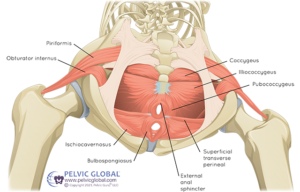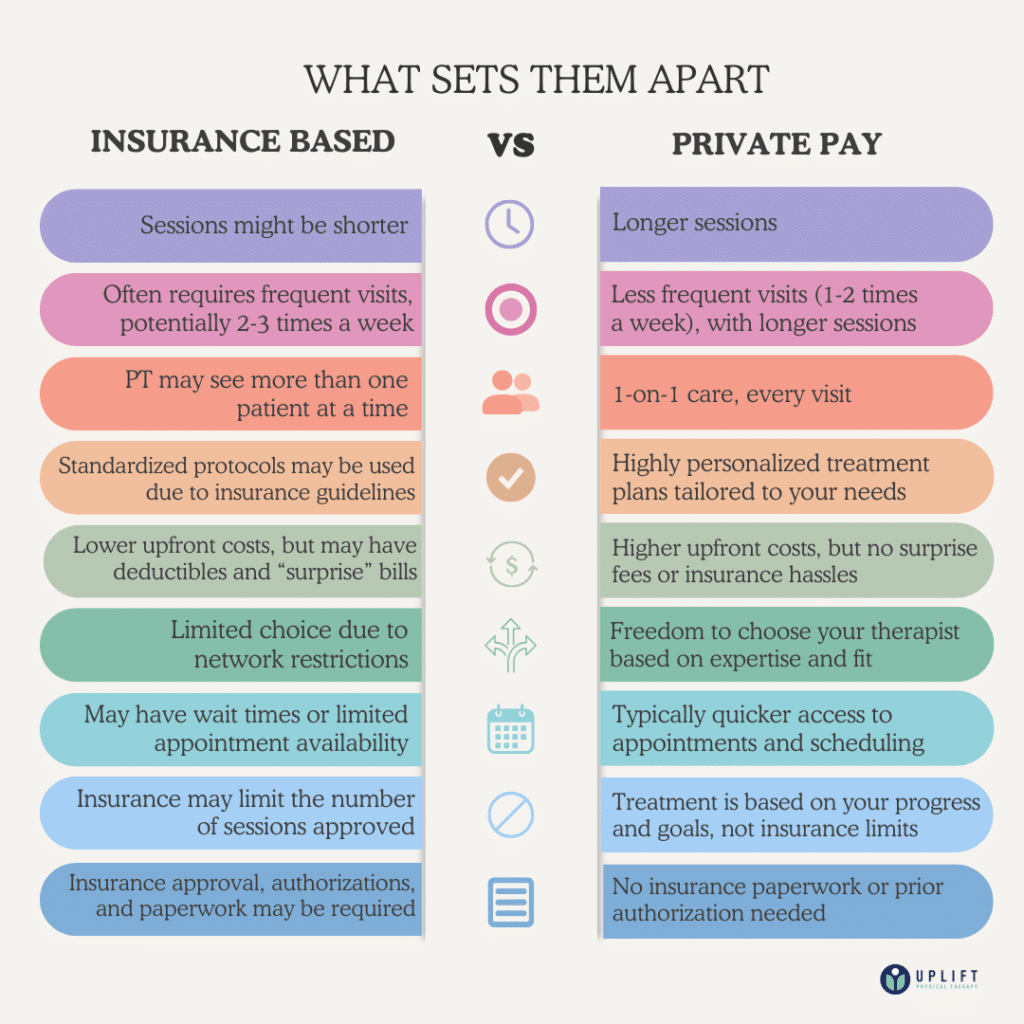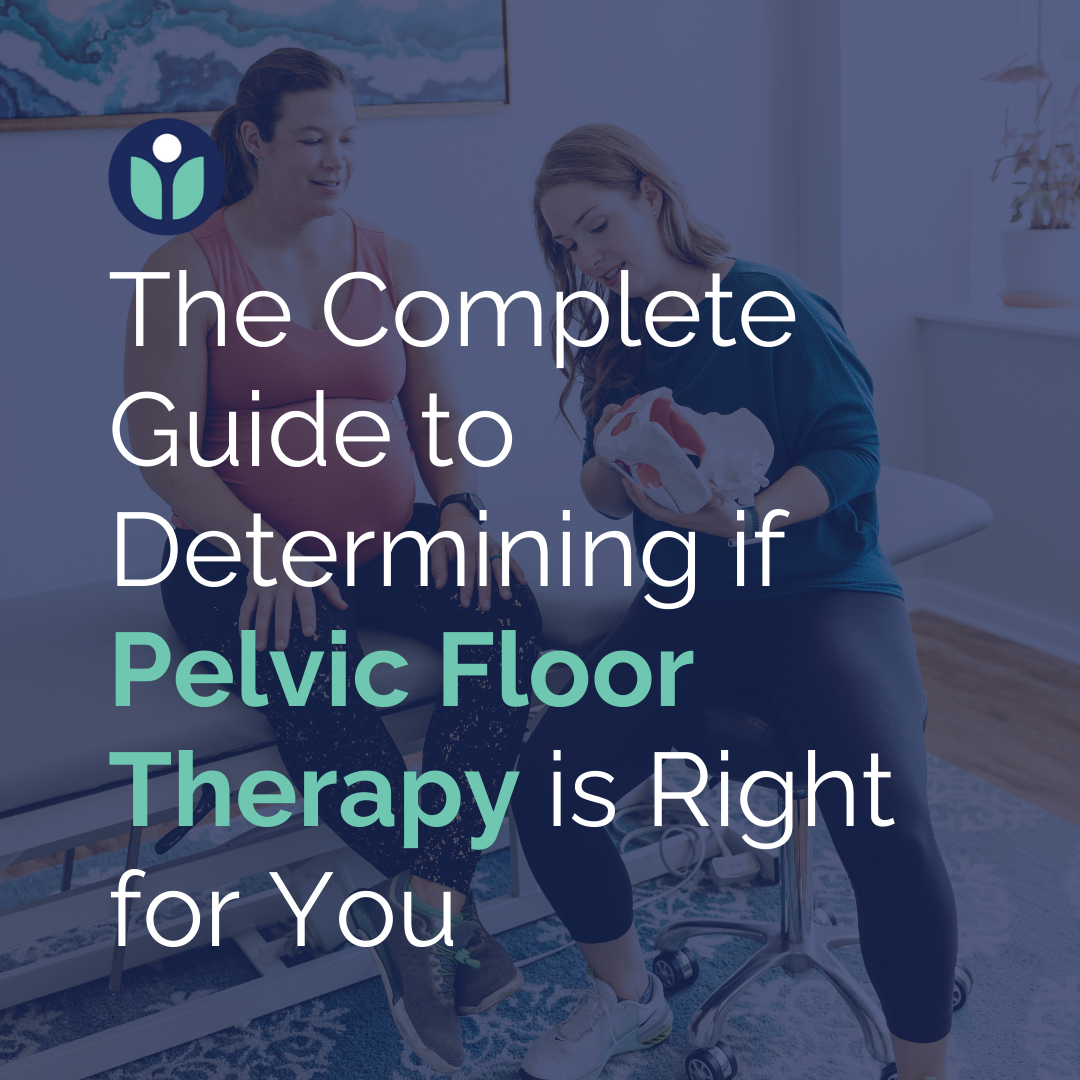The Complete Guide to Determining if Pelvic Floor Therapy is Right for You
The Complete Guide to Determining if Pelvic Floor Therapy is Right for You
Have you ever been told that:
- Peeing your pants after you cough, sneeze, or laugh is just “a normal part of postpartum life.”
- Pain during intimacy is just something women have to deal with, so “Just relax a little and drink a glass of wine.”
- Men can’t have pelvic floor problems, “only women deal with that.”
- Bladder leakage during menopause is just a normal part of aging and “You’ll just need to wear a panty-liner and live with it.”
Spoiler alert: None of that is true or normal!
Welcome to your ultimate guide to all things pelvic floor therapy, where we will tackle all your burning questions and maybe even some you didn’t know you had!
Whether you’re dealing with discomfort, incontinence, postpartum recovery, or even pelvic pain—we’re here to give you the answers you’ve been searching for! At UpLift, we believe you deserve to move and live without pain and bothersome symptoms, and your pelvic floor health plays a HUGE role in that. Let’s dive into everything you need to know about pelvic floor therapy, why it matters, and how it can make a difference in your everyday life.
Here’s what we’ll cover:
- What is pelvic floor therapy?
- What exactly is your pelvic floor, and what does it do?
- Why is a healthy pelvic floor vital to living your best life?
- How is pelvic floor therapy different from traditional physical therapy?
- Starting your pelvic floor therapy journey? Let’s break it down!
- Who can benefit from pelvic floor therapy? (Spoiler: Anyone with a pelvis!)
- Why choose UpLift?
- Is pelvic floor therapy worth the investment?
- Pelvic floor therapy misconceptions…
What is Pelvic Floor Therapy?
Pelvic floor therapy is a specialized type of physical therapy that focuses on the muscles that support your bladder, bowels, and reproductive organs. These muscles are crucial for controlling things like going to the bathroom, sexual function, and even core stability. When something’s “off” with your pelvic floor, it can cause all sorts of frustrating symptoms–from leaking when you sneeze to discomfort during sex to pain during your favorite workouts.

Education is key to healing! Here, a pelvic floor therapist is guiding a patient through the anatomy of the pelvic floor using a detailed anatomical model to foster understanding and empower recovery.
Good pelvic floor therapy doesn’t just stop there! It takes a holistic approach, looking at your whole body, lifestyle, and daily habits. This includes evaluating orthopedic concerns like your hips, back, and core muscles, as well as assessing your posture and how you move throughout the day. By addressing these factors alongside pelvic floor muscle training, pelvic floor therapy helps address and treat these issues by strengthening, relaxing, and retraining these muscles to function correctly. The goal? To help you feel better, move better, and live without pain or leaking.
What is Your Pelvic Floor?
Try thinking of your pelvic floor as the base of your core. It’s a group of muscles that acts like a supportive hammock, holding up your pelvic organs (bladder, rectum, uterus, or prostate). These muscles play a huge role in daily functions such as peeing, pooping, sexual activity, and stabilizing your core.
Your pelvic floor works in tandem with your core, back, and hips to keep everything functioning smoothly. It’s like the foundation of a house–when it’s solid and balanced, everything else feels more stable and supported. If it’s weak or too tight, though, you might notice problems like leaking, pain, pressure, or pain with intimacy.

Understanding your pelvic floor anatomy is the first step in improving your health! This detailed diagram shows all the essential structures from a low-angle view to highlight their importance in body function.
Image used with permission from Pelvic Guru®, LLC as a member of the Global Pelvic Health Alliance Membership (GPHAM).
What Does the Pelvic Floor Do?
Your pelvic floor muscles do a lot of behind-the-scenes work to keep you feeling great:
- Control bladder and bowel function
- Support your organs
- Stabilize your core and spine
- Play a role in sexual function
- Pumps waste products out of the area
In addition to these key functions, your pelvic floor helps maintain proper posture and balance by working in sync with your deep core muscles. It’s constantly adapting to the demands of your body—whether you’re lifting, laughing, or simply sitting—making sure everything stays in check and working as it should.
Why is a Healthy Pelvic Floor Important?
A healthy pelvic floor isn’t just about avoiding discomfort—it’s crucial for maintaining control over your bladder and bowels, supporting your body’s movements, and enhancing sexual function. When things function normally, you move more freely, feel stronger, and experience fewer disruptions in daily life.
Beyond that, a healthy pelvic floor is vital for maintaining balance throughout your entire body. It supports your posture, helps prevent injuries, and ensures that your core muscles can function efficiently, allowing you to move through daily life with ease and confidence! A healthy pelvic floor can lead to:
- Improved Bladder and Bowel Control: Say goodbye to your “oops” moments! A well-functioning pelvic floor helps prevent leakage and allows for smoother, regulated bathroom trips.
- Enhanced Sexual Function: In both men and women, stronger yet mobile pelvic floor muscles can lead to more enjoyable, pain-free intimacy, improving overall sexual health and satisfaction.
- Better sleep quality: A healthy pelvic floor can reduce the frequency of waking up at night to use the bathroom, helping you sleep more soundly.
- Reduced Pain: Whether it’s low back pain, hip discomfort, or pelvic pain, keeping your pelvic floor healthy can help alleviate chronic aches by providing proper support to your core.
- Boosted Posture and Core Strength: A healthy pelvic floor helps maintain good posture by stabilizing your core, which can reduce strain on other parts of your body, like your back and hips.
- Smoother Recovery Postpartum or Post-Surgery: If you’re recovering from childbirth or surgery, a healthy pelvic floor supports faster healing and helps you regain strength and function.
- Help Transition Through Life Stages: If you’re transitioning into menopause, a healthy pelvic floor can set you up for success to help reduce muscle loss and decrease the risk of leakage.
Pelvic Floor Physical Therapy vs. Traditional PT… What’s the Difference?
While all physical therapy focuses on improving movement and reducing pain, pelvic floor therapy takes things a step further. Pelvic floor therapy is highly specialized and requires additional training to understand the intricate details of the pelvic muscles. A pelvic floor therapist won’t just focus on your symptoms—they get to the root cause.
Pelvic floor therapy goes beyond the typical joint and muscle work of traditional PT. It addresses often-overlooked areas of the body that can significantly impact your overall well-being, like your bladder, bowel, and sexual function. You can think of pelvic floor physical therapists as physical therapists that don’t skip any muscles in the body. One aspect of care that makes pelvic floor therapy stand out is that it can include internal exams and treatments, which are not typically a part of traditional physical therapy. Internal exams allow the therapist to get a detailed, hands-on understanding of the strength, tension, and coordination of the pelvic muscles, allowing the therapist to tailor your treatment more precisely. Your therapist will always ensure your comfort level when it comes to addressing these intimate areas by obtaining consent and walking you through the exam and treatment step-by-step.
UpLift’s therapists are highly-trained pelvic floor experts, meaning you’re not just getting general care. You’re getting care tailored to the complexities of YOUR pelvic floor! We focus on the whole body connection, meaning we look at how your pelvic floor affects your posture, breathing, core stability, and more–offering a truly comprehensive approach to healing.
Great, Now Where Do I Start?!
Starting your pelvic floor therapy journey might feel overwhelming at first–especially if you’re not sure where to begin or even how to bring it up to your healthcare provider. But trust us, you’re not alone!
A great first step is finding a therapist who specializes in pelvic floor therapy. You can use the resource below or Herman & Wallace’s Practitioner Locator to track down experts near you.
https://www.aptapelvichealth.org/ptlocator
Remember, it’s completely okay to advocate for yourself! If your provider hasn’t mentioned pelvic floor therapy as an option, speak up and ask about it. We’ve all heard stories of women telling their doctor that sex is painful, or their body doesn’t feel the same after birth and being told, “Just relax and have some wine!” or “That’s just life after babies!” Well, we are here to tell you that is NOT how it is or how it has to be! One of the most used phrases in our clinic is “common, not normal.” While symptoms like incontinence, discomfort, and Diastasis Recti may be common after having a child, they do not have to become your normal, and you do NOT have to live with them! You may find yourself having pain with sex, and it’s not as simple as “just relaxing”; you have to understand that there could be underlying factors like muscle tightness, pelvic floor dysfunction, or even stress that need more than just a quick fix or a glass of wine.
You deserve a treatment plan that addresses the root cause of your symptoms, not just the surface-level issues! It might feel a little stressful to navigate this, but we promise once you take that first step, you’ll be well on your way to getting the help you need and feeling better in your body.
Who Can Benefit from Pelvic Floor Physical Therapy?
You may have heard that pelvic floor therapy is “only for women who’ve had babies,” but that could not be further from the truth. Seriously–whether you’re dealing with specific pelvic issues or simply looking to improve your core and movement, pelvic floor therapy can be a game-changer. It’s not just for one stage of life or one type of person.
We all have a pelvic floor, and we all deserve it to function correctly and not interfere with our daily lives!
Here are some examples of people that can benefit from pelvic floor therapy:
- Athletes: Whether you’re a runner, weightlifter, or yogi, your pelvic floor is part of your core, meaning it plays a crucial role in stabilizing your body and enhancing your performance. It can help prevent injury, improve endurance, and even boost recovery time. If you’re feeling pelvic pain during exercise, experiencing leaking, or just want to level up your game, pelvic floor therapy might be exactly what you need.
- People Dealing with Pelvic Pain: Conditions like endometriosis, interstitial cystitis, or chronic pelvic pain can make daily life pretty tough. Pelvic floor therapy can help manage and relieve pain by addressing the muscle tension or dysfunction often accompanying these conditions.
- Prenatal Moms: Pregnancy and postpartum recovery are key times when pelvic floor therapy can be especially beneficial. During pregnancy, your body goes through many changes–your growing belly puts extra pressure on your pelvic girdle, which can lead to discomfort, back pain, or even leakage. Prenatal pelvic floor therapy can help you prepare for childbirth by strengthening your muscles, improving alignment, and addressing any pain/dysfunction that might pop up along the way.
- Postpartum Moms: After childbirth, many women experience issues like diastasis recti, incontinence, or perineal tearing. Pelvic floor therapy can help speed up recovery, improve core strength, and address any discomfort or dysfunction you might be experiencing. Whether you’re prepping for delivery or healing after, pelvic floor therapy can be a key part of feeling stronger and more supported during this transformative time.
- People Experiencing Incontinence: If you’re leaking when you sneeze, laugh, or jump, pelvic floor therapy can help retrain those muscles and get them functioning properly. This is not just for women–men and older adults can experience incontinence as well.
- Men with Pelvic Floor Dysfunction: It’s a very common misconception that pelvic floor therapy is only for women! Men who deal with pelvic pain, chronic prostatitis, or even erectile dysfunction can benefit greatly. Often, these issues stem from muscular tension or dysfunction, which pelvic floor therapy can address.
- Post-Surgery Recovery: If you’ve had a hysterectomy, prostate surgery, or other pelvic-related surgeries, pelvic floor therapy can help rebuild strength, improve healing, and restore normal function. Surgery can impact the muscles and tissues of the pelvic floor, and therapy can assist in restoring balance and reducing any lingering issues like pain or incontinence.
- Anyone Seeking Core Stability: If you’re focused on building core strength, pelvic floor therapy lays the foundation for a stable, balanced, pain-free core.
- Unrelenting Back, Hip, or Groin Pain: If you’ve undergone other methods of therapy, including airrosti, physical therapy, chiropractic care, and massages, with no relief, the issues may be coming from your pelvic floor. This area is often overlooked, and our therapists specialize in addressing the pelvic girdle region, including checking your hips, back, and pelvis.
- Women Navigating Menopause: While some changes during menopause are common, pelvic floor therapy can help you take a proactive approach to this transition rather than just reacting to the symptoms. The hormonal changes during menopause can affect the pelvic floor, leading to symptoms like urinary urgency, dryness, or even prolapse. Pelvic floor therapy can help manage these changes by strengthening the muscles, improving tissue health, and addressing any discomfort. It’s not about “just dealing with it”—you can take control and improve your quality of life during this transition.
Pelvic floor therapy is truly for everyone, no matter your age, gender, or activity level. If any of this sounds familiar to you, know that there’s help–and you don’t have to deal with it alone!
Common Diagnoses Treated in Pelvic Floor Therapy
Please see the chart below for a list of common diagnoses treated by pelvic floor therapy:

Pelvic floor dysfunction can show up in many ways. This chart provides an overview of common conditions and symptoms, helping you better understand what might be affecting your pelvic health.
Our providers at UpLift are highly specialized and committed to cutting-edge care by staying current with research and interventions. If you have a condition not listed above, don’t worry; this list is not exhaustive. We always go above and beyond to give you the best treatment possible based on your examination and diagnosis. We pride ourselves on being lifelong learners, and we are passionate about helping each patient find relief. No matter your diagnosis, we are committed to understanding your condition thoroughly and providing you with the personalized care you deserve!
What Outcomes Can You Achieve with Pelvic Floor Therapy?
Many people experience significant improvements in their symptoms, leading to a better quality of life. Whether you’re struggling with prolapse, pelvic pain, or incontinence, pelvic floor therapy aims to tackle the root cause of these issues. Understanding and addressing these underlying factors is crucial for long-term relief and recovery. By focusing on what’s going on in your body, pelvic floor therapy provides a more comprehensive approach that not only alleviates symptoms but also helps prevent them from recurring in the future.
You might also find that with consistent therapy, you can regain control over your bladder and bowel functions, reduce or eliminate pain, and improve your overall core strength and stability. Some patients even report enhanced sexual function and pleasure, as well as improved confidence in their daily activities.
While everyone’s pelvic floor journey is unique, the common thread is that patients often leave feeling empowered and equipped with tools to manage their pelvic health. So, if you’re considering pelvic floor therapy, know that it could be a valuable step toward reclaiming your comfort and confidence!
UpLift’s Approach to Pelvic Floor Therapy

Proper lifting mechanics are crucial during pregnancy to prevent strain and support pelvic health. Here, a pelvic floor therapist is guiding a pregnant patient to ensure safe movement and protect her body.
We know that pelvic floor health isn’t commonly discussed, and many people aren’t aware of how vital this aspect of health is to your overall well-being. Pelvic floor therapy isn’t just about addressing discomfort–it’s about understanding your body as a whole. Education about your pelvic floor is crucial for leading a healthy life, yet it’s often overlooked. Our mission goes beyond just ‘slapping a bandaid’ on your symptoms; we believe in empowering you with the knowledge and tools you need to take control of your health.
Our goal is to help you move better, feel better, and live without pain. We combine traditional physical therapy techniques with holistic, body-centered care to create a comprehensive approach that promotes healing from the inside out. Our therapists are highly trained specialists who dive deep into the complexities of pelvic health, ensuring you receive care that’s tailored specifically to you. We understand that every person is different, which is why we take the time to educate you about your body and pelvic floor, making sure you’re equipped with the right tools and strategies to continue your progress outside of our clinic. We hope to foster a supportive environment where you feel empowered, comfortable, and confident in your healing journey.
We’re here to celebrate your victories, no matter how small, and to provide ongoing support as you navigate the path to better health. Choosing UpLift means choosing a partner who genuinely cares about your well-being and is dedicated to helping you reclaim your quality of life!
See for yourself; here’s what some former patients have said about their pelvic floor journey with UpLift PT:
“Uplift PT has been a lifesaver. After receiving poor care from my PCP and being on 5 different cycles of antibiotics in 6 weeks, I was feeling really defeated by my IC diagnosis. When I did my initial consult with Melissa, she was very realistic and positive about my ability to reduce/be proactive with flare-ups and return to the level of activity I enjoy. Since starting with Uplift, I have had no flare-ups and very few, very minimal irritation issues that occurred daily before. Uplift has been so worth the time and investment to return to a level of functioning that I had not had in over 3 months.” -Leah E.
“I got my life back. Thanks to Dr. Melissa and the Uplift team for taking such amazing care of me. I’m back to doing everything I could before my surgery and more. Dr. Melissa is so kind, professional, and knowledgeable.” -Michael S.
“Amber and the team at Uplift are amazing! I had initially attended a free pelvic floor class at our CrossFit gym when I was 25 weeks pregnant. When we did some of the pelvic floor/core tests, It was pretty obvious that I was going to need more assistance after pregnancy to help get my body back in shape. Around 6 months postpartum, I made my first appointment and did not regret it one bit. I had a pretty bad case of DR, with the majority of my core being 3 fingers width apart. Now I am mostly a 1 with a couple of spots around the 2 range. So much progress! Amber has helped me so much. The knowledge I have accumulated these past 2 months has been incredible. From correct breathing to lifting and everything in between, I can’t wait to see how much progress we will make in the next month. Thank you, Uplift team!” -Selena N.
“Amanda has provided me with a new set of skills and solutions to an area in my life as a woman over 65 that I had begun to think was impossible. It has changed my confidence level as well as my physical strength. She helped isolate the primary issue and created a doable yet progressive pattern of movements I could perform throughout my day based on my schedule, which created high returns. This is how wellness should be!!” -Suzanne G.
Common Pelvic Floor Misconceptions
- “Pelvic floor therapy is only for women who’ve given birth.”
- While postpartum women can certainly benefit from pelvic floor therapy, it’s important to remember that anyone can experience pelvic floor issues.
- “Kegel exercises are all I need for a healthy pelvic floor.”
- Kegels can be helpful, but they aren’t the complete solution for everyone. A comprehensive assessment is key to determining the best approach and exercises for your individual needs.
- “Men don’t have pelvic floors.”
- Surprise! Men absolutely have pelvic floors, and they can experience a range of issues like pelvic pain and erectile dysfunction. Pelvic floor therapy is just as important for men’s health.
- “It’s too embarrassing to talk about pelvic floor issues.”
- Many people feel shy when discussing these topics, but our therapists create a warm, welcoming environment where you can feel safe to share your concerns. Trust us, you’re not alone, and there is no such thing as ‘TMI’ in a pelvic floor therapy clinic!
- “Pain during sex is normal, I just need to relax.”
- While many people think that discomfort during intercourse is something to simply accept, it’s often a sign of underlying issues. Pelvic floor therapy can help address the root causes of painful sex, improving intimacy and comfort.
- “Not being able to hold my bladder is just part of getting older; I can carry extra pads!”
- Here’s the truth: you don’t need to accept leakage like it’s a surprise guest at a party. Aging doesn’t mean you have to live with urinary leaks. Pelvic floor therapy can help you reclaim control so you can live life without worrying about any “oops” moments!
- “Pelvic pain is normal; I just need to tough it out.”
- Ah, the classic “pain is just weakness leaving the body” mindset! While we admire your toughness, let’s not confuse pelvic pain with a badge of honor. Just because it’s common doesn’t mean it’s normal. You deserve to find out what’s causing the pain and how pelvic floor therapy can help you kick your discomfort to the curb!
- “My doctor would have referred me to pelvic floor therapy if I needed it.”
- Unfortunately, not all healthcare providers are well-informed about the benefits of pelvic floor therapy. It’s important to advocate for yourself and ask for a referral if you feel it might help your situation.
- “It’s too late for me to improve my pelvic health.”
- No matter your age, season of life, or how long you’ve been experiencing issues, it’s NEVER too late to seek help. Pelvic floor therapy can lead to significant improvements at any stage in life.
- “If I ignore it, it will go away.”
- Spoiler alert: it won’t. Pretending your pelvic floor issues don’t exist is like ignoring a text from your best friend–eventually, it’ll catch up with you! Addressing these concerns can lead to better health and peace of mind.
- “Pelvic floor therapy is only for people with diagnosed conditions.”
- You don’t need to have a specific diagnosis to benefit from pelvic floor therapy. Many individuals seek therapy for preventative care, improving core strength, or enhancing performance.
- “I can just Google exercises.”
- While there’s a wealth of information online, Dr. Google is not always the best! We recommend an assessment from a qualified therapist to ensure you’re doing the right exercises for your unique needs.
What to Expect at Your First Pelvic Floor Therapy Session
When you walk into your first pelvic floor therapy session, you can expect a warm and welcoming environment. Most likely, your therapist will start with a detailed evaluation of your medical history, discussing your symptoms and any concerns you might have. They’ll take the time to listen, ensuring they understand your unique situation. After that, a thorough examination may follow, which could include an internal pelvic floor assessment (with your consent, of course). It’s normal to feel a bit nervous, but know that everything will be explained clearly, and your comfort should always be the priority. By the end of the session, you should expect a tailored treatment plan designed specifically for you.

Your first visit is all about understanding your unique needs. Here, a pelvic floor therapist is taking the time to review the patient’s history and treatment goals to create a personalized plan for their care.
At UpLift, we go the extra mile to make your first visit as comfortable and informative as possible. Once you arrive, one of our administrators will help get you checked in, offer you water, and give you a quick clinic tour. When it’s time for your appointment, your therapist will come out and greet you on time and bring you back to a private treatment room to get started. Our therapists are not just skilled practitioners; they’re also your allies on this journey to better pelvic health. We strive to create a welcoming, safe environment where you feel like your story matters. Your therapist will listen and ask follow-up questions to gain a better understanding of your unique concerns and goals. Our holistic, whole-body evaluation approach means we’ll blend traditional techniques with body-centered care to address the root causes of your concerns. And, of course, any assessments, including internal evaluations, will be approached with sensitivity and clear communication. Your comfort is always the most important thing! Together, we’ll create a personalized treatment plan that empowers you to reclaim your health and well-being, making the journey approachable and manageable without feeling overwhelmed.
How Much Time Do I Have to Invest?
We wish it were a “one-time fix,” but the truth is many pelvic floor issues can take time, understanding that it is more of a journey than a bandaid. We want to fully address your concerns, and it is a process that takes time to achieve the outcomes you want.
Every person’s journey through pelvic floor therapy is unique, and the time required can vary widely based on individual symptoms and goals. Generally, it’s important to expect multiple sessions to achieve lasting results. While some people notice improvements in just a few weeks, others may require a couple of months to fully address their concerns and regain optimal function.
During your initial evaluation, your therapist will assess your specific needs and develop a customized treatment plan. This plan not only outlines the frequency of visits but also integrates exercises and techniques you can practice at home, making your progress a collaborative effort.
Most importantly, remember that consistency is key! Regular attendance can accelerate your healing process as each session builds upon the last. It’s not just about showing up; it’s about the commitment to understanding and nurturing your pelvic health. So, whether it takes a few weeks or months, rest assured that you’re investing in a healthier, happier you!
At UpLift, we navigate this journey with you, celebrating your progress and adjusting your plan as needed to ensure you’re getting the most out of your therapy.
Insurance-Based Clinics VS. Private Pay Clinics: What’s The Difference?
When considering physical therapy options, it’s important to understand the differences between insurance-based and private-pay clinics. While both can provide high-quality care, they often have different approaches to treatment, scheduling, and cost structure. The chart below outlines some key distinctions to help you make an informed decision about which type of clinic may better suit your needs.

Not all physical therapy experiences are the same! This comparison chart breaks down the key differences between insurance-based clinics and private pay options—helping you make an informed choice about your care.
How Much Does Pelvic Floor Therapy Cost?
The cost of pelvic floor therapy can vary based on factors such as your specific needs and the number of sessions required. Since pelvic floor therapy is a specialized service, it often operates on a private pay or out-of-network basis. This means many patients may need to utilize their out-of-network benefits, such as HSA or FSA funds. Many offices will also provide you with a Superbill receipt, which is an itemized, coded receipt that you can submit to insurance for potential reimbursement. On average, you might expect costs to range from $160 to $280 per session, depending on your location and the therapist’s expertise. We recommend calling your local pelvic floor therapist and asking for a cost breakdown if you have further questions.
That’s Really Expensive…Why Should I Invest in Pelvic Floor Therapy?
While this may seem daunting at first, many individuals find the value far outweighs the cost–especially when they start experiencing life-changing results, such as reduced pain, improved function, and enhanced quality of life.

At Uplift, we’re all about making fitness and healing family-friendly! This mom is working on deep-core engagement with the support of her little one, showing that strength-building can be a family affair.
“I saw Dr. Rachel during my second and third trimesters, and it made all the difference in my feeling confident about what was going on in my body during pregnancy. When I was pushing (with the epidural so I couldn’t feel anything below my waist), my OB was so impressed by how effective my pushing was because of all of the practice of deep core engagement and Dr. Rachel teaching me how to push before that I DIDN’T TEAR!!!! 🙌🏼🙌🏼🙌🏼🙌🏼🙌🏼🙌🏼 That is all thanks to you guys, especially Dr. Rachel. After I delivered, he said, “You should write a book about how to push,” and I gave all the credit to pelvic floor PT. Absolutely the best investment I made into my pregnancy.” -Amber P.
We understand that the financial aspect can be a barrier, and we’re here to help you navigate it. Our team can work with you to outline your treatment plan and discuss available payment options. Remember, this is an investment in your health and well-being, and every step you take toward addressing pelvic floor issues is a step toward a more vibrant life.
Do I Have Pelvic Floor Dysfunction?
If you’re still unsure whether pelvic floor therapy is right for you, try UpLift’s quick screening quiz below to find out! Pelvic floor dysfunction is more common than you might think, and early intervention can make a big difference in your recovery.
UpLift Physical Therapy’s Pelvic Floor Dysfunction Screening Quiz
Choose: Yes, Sometimes, No
- I have pain in the lower back, pelvis, abdomen/groin, or hip area that has been unresolved.
- I am losing sleep due to the symptoms in the pelvis area that I have been experiencing.
- I am not happy with my intimacy due to my symptoms.
- I have unwanted pressure/discomfort in my rectum, bladder, or private area.
- When I am peeing or pooping, I have difficulties that can include one of the following:
- Unwanted leakage (even if it is dropped) or pass wind (fart)
- Feel like I can’t make it to the bathroom
- Straining or pushing
- Feel like I can’t empty
- Have to go multiple times even though I just went
- I have a lot of heaviness/pressure in my abdominal, pelvis, or private area that I can’t explain.
- I have to change my daily activities/lifestyle around my symptoms.
- I am going through or have been through hormonal changes that have created or worsened my symptoms.
- I am seeking fertility planning, currently pregnant or postpartum, and want to be proactive in my management of pelvic health.
- When I am active, I notice my symptoms do not improve or worsen.
- I have undergone surgery in the abdomen or pelvis, and I have not had follow-up rehab care (hysterectomy, cystoscopy, c-sections, and tummy tuck procedures).
- I don’t have any symptoms currently, but I want to set myself up for success in my pelvic health.
Key:
If you checked yes or sometimes to 1 or more of the symptoms, please consider giving us a call.
If you checked yes to more than 3 statements, please call us to set up an initial consultation.
If you checked yes to more than 5 statements, please call to book your initial consultation and follow-up treatments created just for you.
If you answered “Yes” or “Sometimes” to any of these questions, you could benefit from pelvic floor physical therapy that would include an initial evaluation and subsequent treatment sessions.
Please note it is also important to speak to your primary care doctor or pelvic health provider regarding unmanaged pelvic symptoms.
In Conclusion…
Pelvic floor therapy can be a total game-changer for anyone dealing with pain, weakness, or discomfort in their pelvic region. Many people are surprised to learn just how interconnected pelvic health is with overall well-being; addressing these issues can lead to improvements in everything from physical activity to emotional health. By prioritizing your pelvic health, you’re not just addressing symptoms–you’re empowering yourself to live life to the fullest.

From core strength to proper squat form, our therapists are here to guide you every step of the way. Whether you’re on the Pilates reformer or refining your squat techniques, we’re here to help you build strength and confidence.
At UpLift, we are dedicated to providing compassionate care tailored to your unique needs. Our team is here to guide you on this journey, ensuring you feel comfortable and informed every step of the way.
Ready to prioritize your pelvic health? Book your free 15-minute phone consultation, and let’s get you on the path to feeling your best!
https://link.srvcsndr.com/widget/booking/jjZlhXoKFYfoWsP6lmDY
If you didn’t click the link and book, please know there are other ways to engage with us:
- Pelvic Floor Dysfunction Screening
- Follow us on Instagram @upliftptp
- Stay up to date with all things UpLift by joining our mailing list (can be found in the bar on the right-hand side of your screen)
Thanks For Reading!
We know that pelvic floor therapy can feel a little intimidating, but the fact that you’re here shows you’re already taking a step in the right direction. Remember, you’ve got this—and we’re here to support you every step of the way.
Contact Us
UpLift Physical Therapy Website
Phone: 210-468-7398
Follow us on social media: Instagram @upliftptp

